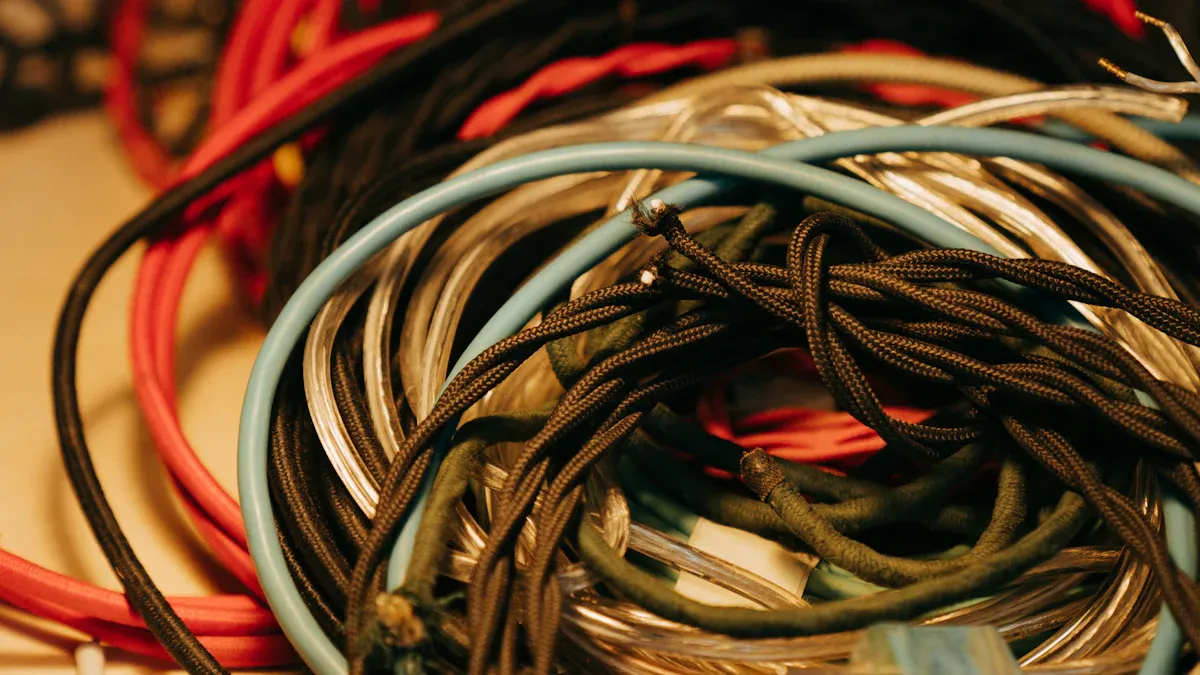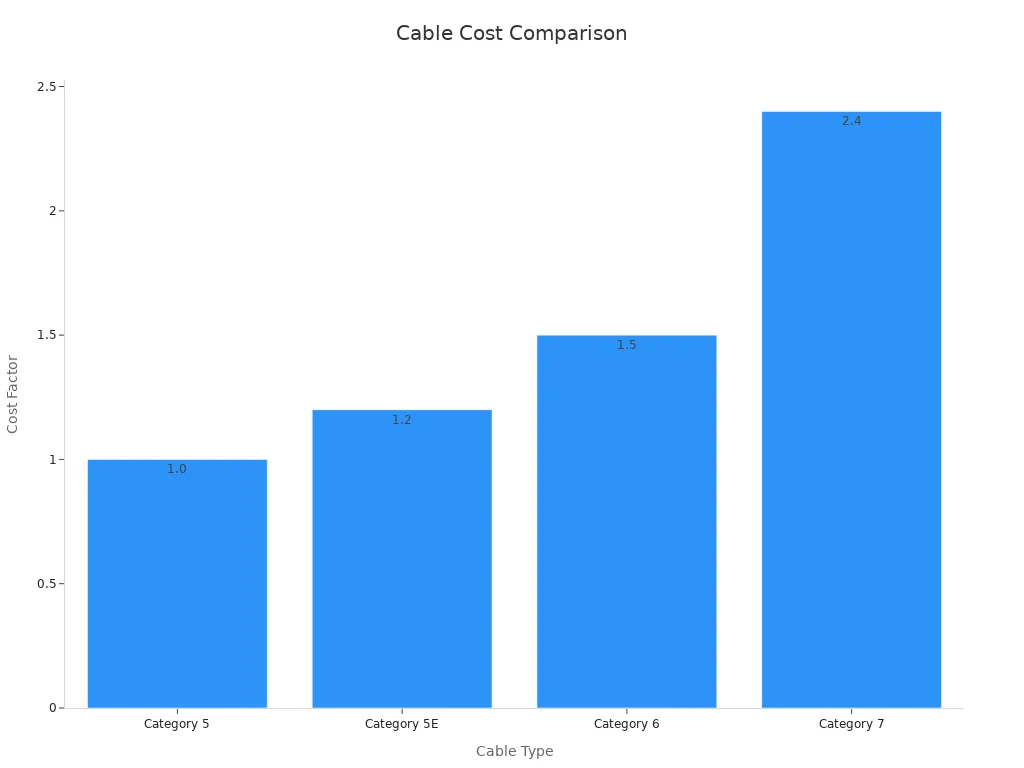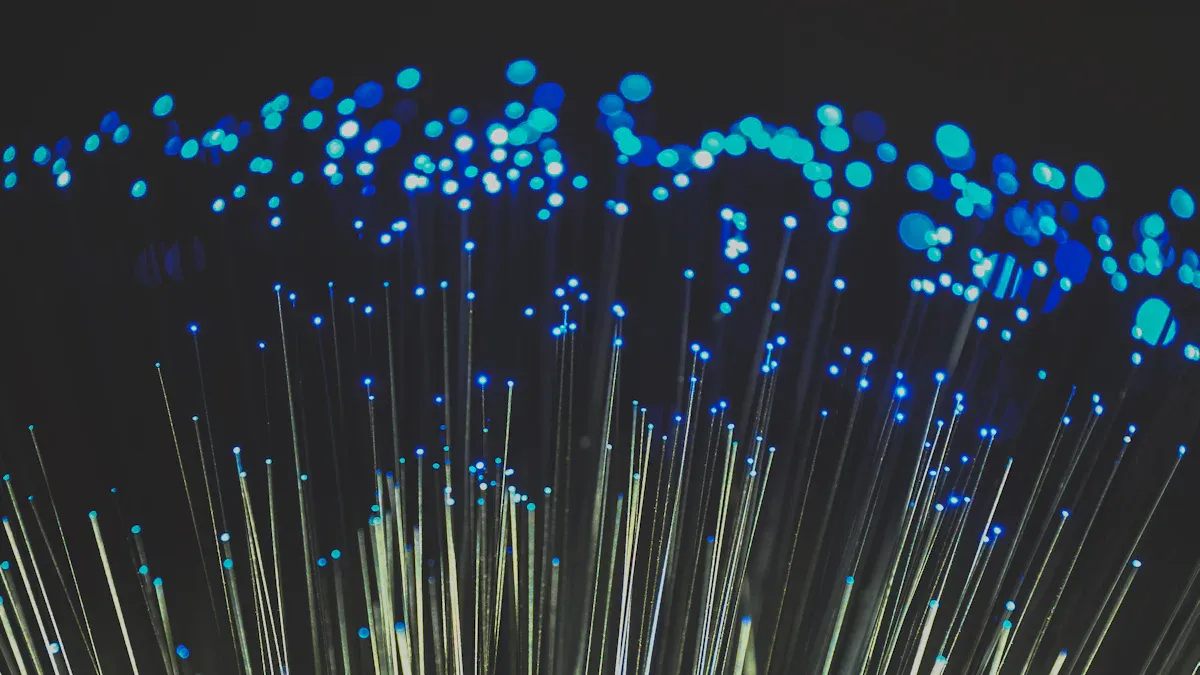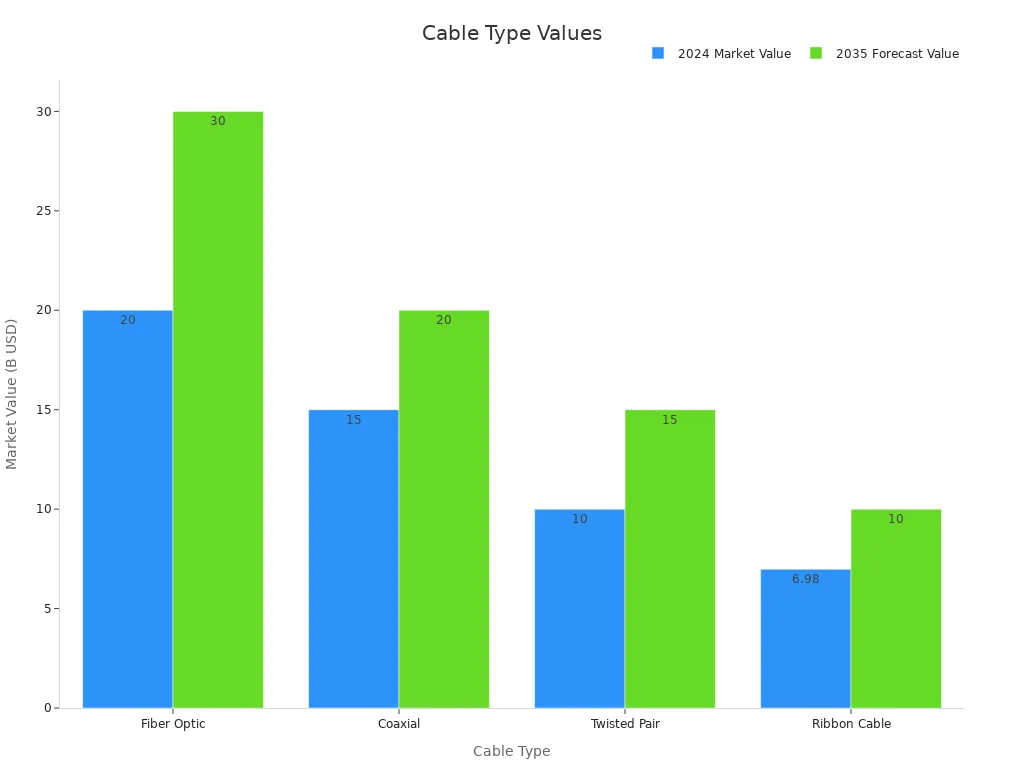Which Telecom Cable Is Best for You Fiber Optic vs Coaxial vs Twisted Pair

Choosing the right telecom cable depends on your needs. Fiber optic cable stands out for the fastest internet speeds and reliable performance over long distances. Recent records show fiber cables can transmit data at up to 1.7 petabits per second over 41 miles. Twisted pair cables work well for affordable home or office internet, while coaxial cables remain popular for TV and moderate-distance internet. Users should weigh speed, distance, cost, simple installation, and durability. Each cable type offers unique strengths for different scenarios.
In 2023, fiber optics achieved a record 1.7 petabits per second over 41 miles.
Over 50 countries now offer 1 Gbps fiber optic internet.
Fiber cables transmit data at nearly two-thirds the speed of light.

Key Takeaways
Fiber optic cables offer the fastest speeds, longest distances, and best reliability, making them ideal for businesses and long-distance telecom links.
Twisted pair cables are the most affordable and easiest to install, perfect for home and small office networks with moderate speed needs.
Coaxial cables provide a good balance of cost and performance, commonly used for TV and broadband internet with moderate distance requirements.
Choosing the right cable depends on factors like speed, distance, cost, interference resistance, and installation complexity to match your specific needs.
Fiber optic cables are future-proof, supporting growing data demands and new technologies, but they require higher upfront costs and skilled installation.
Telecom Cable Types
Understanding the main types of telecom cable helps users choose the best option for their needs. Each cable type offers unique features, performance benchmarks, and ideal applications.
Cable Type | Market Prevalence & Applications | Performance & Characteristics |
|---|---|---|
Fiber Optic Cable | Dominates global telecom cable market; used in data centers, 5G. | High bandwidth, very low signal loss, supports long distances; single-mode for long range, multi-mode for speed. |
Coaxial Cable | Common for cable TV, broadband internet, digital video. | Moderate distance, strong shielding against interference; RG59 for short runs, RG6 for digital signals. |
Twisted Pair Cable | Standard in telephony, LANs, and home networks. | Cost-effective, easy to install, lower bandwidth than fiber; UTP and STP types available. |
Fiber Optic Cable
Fiber optic cable uses optical fibers made from glass or plastic to transmit data as light pulses. This technology delivers the highest bandwidth and fastest internet speeds. Fiber supports long-distance data transmission with minimal signal loss. Optical fiber cables remain immune to electromagnetic interference and provide secure, reliable connections. Industries such as healthcare, defense, and smart cities rely on fiber for critical data transfer. Fiber optic cable withstands harsh environments, including extreme temperatures and moisture, making it suitable for both urban and remote installations. Fibre dominates the global telecom cable market, especially in regions investing in 5G and digital infrastructure.
Coaxial Cable
Coaxial cable features a copper core surrounded by insulation and multiple shielding layers. This design protects signals from interference and supports moderate-distance data transmission. Coaxial cables, such as RG59 and RG6, are widely used for cable TV, broadband internet, and digital video. Many cable operators and ISPs continue to use coaxial internet cables for cost-sensitive applications. Coaxial remains relevant where fiber installation is not practical or where existing infrastructure supports coaxial. The cable’s durability and shielding make it a reliable choice for home entertainment and broadband services.
Twisted Pair Internet Cables
Twisted pair cable consists of two copper wires twisted together to reduce crosstalk and electromagnetic interference. These cables are standard in telephony and Ethernet LANs. Twisted pair internet cables, including unshielded (UTP) and shielded (STP) variants, offer a cost-effective and easy-to-install solution for home and office networks. Controlled studies show that twisted pair cables, when properly installed and tested, deliver reliable performance in real-world home networks. Outdoor-rated twisted pair cables, such as Cat 6, withstand weather and physical stress, making them suitable for smart home and agricultural applications. Fibre continues to grow, but twisted pair cable remains essential for short-distance and budget-friendly network installations.
Key Features Comparison

Speed and Bandwidth
Speed and bandwidth represent two of the most important factors when selecting telecom cables. Fibre leads the industry in both areas. Optical fiber cables deliver speeds from 10 Mbps up to 800 Gbps, with bandwidth reaching hundreds of GHz. This capacity supports high-speed connection needs for streaming, gaming, and business applications. Twisted pair cable, such as Cat5 or Cat6a, supports up to 10 Gbps and bandwidth from 100 MHz to 1000 MHz. Coaxial cable typically offers speeds between 10 Mbps and 100 Mbps, with bandwidth around 750 MHz.
Cable Type | Speed Range | Bandwidth Range | Maximum Distance |
|---|---|---|---|
Fiber Optic | From 10 Mbps up to 800 Gbps | Hundreds of GHz | Up to 100 km |
Twisted Pair | Up to 10 Gbps | 100 MHz (Cat5) to 1000 MHz (Cat6a) | Up to 100 m |
Coaxial | 10 Mbps to 100 Mbps | Around 750 MHz | Up to 500 m |
Fibre enables high speed communications and supports future network upgrades. Optical fiber also provides consistent data transmission rates, even under heavy use. Twisted pair cable works well for most home and office networks but cannot match the performance of fibre. Coaxial cable remains suitable for moderate-speed internet and TV services.
Distance and Signal Loss
The difference in maximum distance and signal loss between these cables is significant. Fibre supports data transmission over several kilometers, with some single-mode optical fiber reaching up to 200 kilometers. This makes fibre ideal for long-distance telecom links and high-volume data transfer. Twisted pair cable, in contrast, supports up to 100 meters for high-speed connections. Coaxial cable can transmit data up to 500 meters, making it a middle-ground solution.
Feature | Fiber Optic Cables | Copper Cables |
|---|---|---|
Maximum Distance | Several kilometers (up to 200 km) | Up to 100 meters (high-speed) |
Data Transmission Speed | Up to 800 Gbps (future 1.6 Tbps) | Up to 10 Gbps (limited distance) |
Signal Loss / EMI | Immune to EMI, minimal degradation | Susceptible to EMI, signal loss |
Power Consumption & Heat | Lower | Higher |
Optical fiber cables remain immune to electromagnetic interference (EMI), which preserves signal quality and ensures reliable performance. Twisted pair and coaxial cables, both made from copper, are more susceptible to EMI and signal degradation. This difference affects the stability and clarity of data transmission, especially in environments with electrical noise.
Note: Fibre’s immunity to EMI and low signal loss make it the preferred choice for environments with high interference or where long-distance transmission is required.
Cost and Installation
Cost and installation complexity often influence cable selection. Twisted pair cable offers the lowest installation cost and is easy to install, making it popular for short-distance and budget-friendly projects. Coaxial cable has a moderate installation cost and is also easy to install, but it requires careful connector management to prevent signal leakage. Fibre has the highest installation cost and requires skilled labor due to its fragility and the need for specialized equipment.
Cable Type | Installation Cost | Maintenance Cost & Requirements | Advantages | Disadvantages |
|---|---|---|---|---|
Twisted Pair | Lowest cost, easy to install | Requires routine maintenance due to lower durability | Cost-effective, pliable, easy to install, good for short distances | Lower durability, susceptible to EMI, higher attenuation |
Coaxial | Moderate cost, easy installation | Durable, less frequent maintenance needed | Very durable, easy to install, good for short distances | Signal loss over long distances, signal leakage at connectors, speed fluctuations under heavy use |
Fiber Optic | Highest cost, complex installation | Higher maintenance due to fragility and need for amplifiers over long distances | EMI-resistant, high transmission capacity, good for long distances | Expensive, fragile, harder to install, requires additional components like EDFAs |
Twisted pair cable keeps costs low but may require more frequent maintenance. Coaxial cable balances cost and durability, while fibre justifies its higher price with superior performance and future-proofing for growing data needs.
Durability and Lifespan
Durability and lifespan show another key difference among these cables. Fibre, while delicate during installation, resists environmental hazards such as extreme temperatures, moisture, and chemicals. Optical fiber does not degrade as quickly as copper, so it offers a longer lifespan and maintains high performance over time. Coaxial cable, with its extra insulation and shielding, lasts longer than twisted pair cable and resists physical damage better. Twisted pair cable, though cost-effective, is more vulnerable to wear, electromagnetic interference, and physical stress, leading to a shorter lifespan and higher maintenance needs.
Fiber optic cables provide reliable data transmission and signal quality for many years, especially in outdoor or high-interference environments. Coaxial cable serves well in home entertainment and broadband, offering a good balance of durability and ease of installation. Twisted pair cable remains a practical choice for short-term or low-budget network installations but may require replacement sooner.
Tip: For users seeking long-term reliability and minimal maintenance, fibre stands out as the best investment, especially for high-speed data transfer and demanding network environments.
Internet and Network Use Cases
Home Internet
Most households rely on wired telecom cables for internet access. Twisted pair cables, such as Cat5e or Cat6, remain the most cost-effective option for basic home internet needs. These cables support speeds up to 1 Gbps, which meets the requirements for streaming, online gaming, and remote work. However, they can be susceptible to noise and higher attenuation, which may affect reliability in environments with significant electrical interference.
Coaxial cables offer a step up in performance. They provide better signal protection and anti-jamming features, making them suitable for homes that require more stable connections or have longer cable runs. Coaxial cables deliver up to 80 times the transmission capacity of twisted pair cables and maintain signal quality over moderate distances.
Fiber optic cables represent the premium choice for home internet. They deliver extremely high speeds and reliability, with up to 26,000 times the transmission capacity of twisted pair cables. Fiber optics experience very low attenuation and are immune to electromagnetic interference. However, the cost of installation and service often exceeds what most households need for typical usage.
Cable Type | Speed Capacity | Reliability Features | Cost Consideration |
|---|---|---|---|
Twisted Pair (UTP) | Up to 1 Gbps (CAT5e) | Susceptible to noise and high attenuation | Most cost-effective option |
Coaxial | 80x twisted pair | Anti-jamming, better signal protection | Slightly higher cost than twisted pair |
Fiber Optic | 26,000x twisted pair | Very low attenuation, high speed and reliability | Significantly higher cost |
Note: Wireline internet, including coaxial and twisted pair cables, remains the primary method for home broadband in the US. Most homes use around 600 GB of data per month, and many plans offer data caps of 1 TB or more. Fiber optic service provides the fastest speeds, but twisted pair and coaxial cables offer a balanced solution for speed, reliability, and cost.
Business Networks
Business environments demand high uptime, robust security, and scalability. Fiber optic cables excel in these areas. They provide extremely high reliability, with uptime rates reaching 99.999%. Fiber optics also offer advanced security features, supporting compliance and data governance for sensitive business data. Their virtually unlimited capacity allows businesses to scale quickly and adopt new technologies without major infrastructure changes.
Coaxial cables can serve smaller offices or localized operations. They leverage existing infrastructure and offer lower initial costs. However, coaxial cables are more prone to performance degradation due to shared infrastructure and environmental interference. Their scalability is limited, and upload speeds often lag behind fiber.
Aspect | Fiber Optic Cable | Coaxial Cable |
|---|---|---|
Uptime | Extremely high reliability (99.999%) | More prone to performance degradation |
Security | Advanced features for compliance and data governance | Less advanced, more vulnerable |
Scalability | Virtually unlimited, supports rapid growth | Limited by infrastructure and data caps |
Speed | Symmetrical, scalable to 100 Gbps | Lower peak speeds, affected by neighborhood usage |
Cost | Higher upfront and monthly costs | Lower cost using existing infrastructure |
Installation | More complex | Easier with existing cable TV lines |
Tip: Fiber optic cables best serve businesses that require consistent high-speed data, secure connections, and future-proof infrastructure. Coaxial cables may suit small offices with modest needs, but they cannot match fiber’s performance for demanding applications.
TV and Broadband
Coaxial cables have long been the standard for TV and broadband connections. They use copper conductors to transmit electrical signals and support both analog and digital services. Coaxial cables deliver internet speeds from 10 Mbps to 1 Gbps, depending on network congestion and signal degradation. They require components like cable modems, splitters, and amplifiers to maintain signal strength over longer distances.
Compared to DSL, coaxial cables generally provide faster and more reliable internet connections. Fiber optic cables now offer even higher speeds and symmetrical upload and download rates. Fiber also resists electromagnetic interference and provides superior security. However, coaxial cables remain a cost-effective and practical choice for TV and broadband, especially where fiber is not available.
Coaxial cables remain the primary medium for cable TV and broadband in many regions.
Fiber optic cables offer the best performance but may not be available or necessary for all users.
Coaxial networks require additional equipment to maintain signal quality over distance.
Callout: For most TV and broadband needs, coaxial cables deliver reliable service at a reasonable cost. Fiber optics provide an upgrade path for users who need higher speeds or enhanced security.
Long-Distance Telecom Cable Links
Long-distance data transmission presents unique challenges. Fiber optic cables outperform other types in this scenario. Recent field experiments have demonstrated stable, high-capacity transmission over distances exceeding 1,000 kilometers, even under harsh environmental conditions like wind and rain. Advanced technologies, such as multicore fibers, optical amplifiers, and low-loss splicing, help maintain signal integrity and minimize loss over vast distances.
Linden Photonics highlights that long-distance fiber optic transmission faces issues like signal loss and dispersion. Solutions include optical amplifiers, signal regeneration, and high-quality connectors. Single-mode fibers and amplification enable connections between cities or even countries, spanning hundreds to thousands of kilometers.
Twisted pair and coaxial cables cannot match fiber’s performance for long-distance links. Their higher attenuation and susceptibility to interference limit their use to shorter runs.
Tip: For intercity, international, or backbone telecom links, fiber optic cables provide unmatched reliability, capacity, and resilience against environmental stresses.
Choosing the Right Telecom Cable
Factors to Consider
Selecting the best telecom cable involves more than just speed or price. Users should evaluate several technical and practical factors to ensure the cable matches their needs.
Cable length and type: The chosen cable should match the distance between devices to minimize signal loss. Twisted pair, coaxial, and fiber optic cables each serve different applications and performance levels.
Shielding and interference resistance: High electromagnetic or radio frequency interference in the environment requires cables with strong shielding to maintain signal quality.
Bandwidth and speed capabilities: Users must determine the required data rates and bandwidth. Fiber optic cables offer the highest speeds and longest distances.
Connector type compatibility: The cable connectors, such as RJ-45, BNC, or SC, must fit the devices to prevent signal loss.
Cost and quality balance: Reliable manufacturers and high-quality materials help ensure durability and performance while staying within budget.
Performance standards: Metrics like insertion loss and attenuation should meet network requirements.
Environmental durability: Temperature, moisture, and physical conditions at the installation site affect cable choice.
Fiber counts and types: Single-mode and multimode fibers suit different distance and bandwidth needs.
Proper cable management and installation: Correct installation prevents interference and maintains performance.
Tip: Careful planning and matching cable specifications to the environment and application can prevent costly upgrades or replacements later.
Future-Proofing with Fibre Optic Internet Cables
Fibre optic internet cables provide a strong foundation for future network demands. Coherent optical technology now boosts capacity up to 1000 times more than traditional analog optics, supporting higher bit rates and more users without major infrastructure changes. This advancement helps networks deliver fast, reliable service to many homes and businesses.
Fiber optics stand out as 'future proof' because they resist performance loss, offer strong security, and last longer than copper cables. Innovations like wavelength division multiplexing and orbital angular momentum technology keep increasing bandwidth and scalability. Fiber supports new technologies such as quantum networking, 5G/6G, IoT, and smart cities. Industry standards continue to improve, with 10GPON, 25GPON, and 100GPON pushing speeds even higher. Research into hollow-core and multicore fibers promises even greater data capacity and efficiency.
Future-Proofing Measure | Description |
|---|---|
Hollow-Core Fiber | Transmits light through air, enabling ultra-high-speed data transfer and lower latency. |
Bend-Insensitive Fiber | Flexible routing in tight spaces without performance loss. |
Multicore Fiber | Multiple signals in one cable, increasing bandwidth and reducing costs. |
Biodegradable Coatings | Environmentally friendly, suitable for temporary or seasonal installations. |
Energy Efficiency | Lower power use, fewer repeaters, and reduced operational costs. |
Durability and Longevity | Resists corrosion and interference, reducing maintenance needs. |
Support for Emerging Tech | Enables advanced technologies like quantum networking and IoT. |
A dedicated fibre connection ensures users can meet growing data needs and adapt to new digital services. As fiber optic cables become more affordable and easier to install, they offer a practical and scalable solution for both current and future requirements.
Fiber optic cables lead for high-speed business networks and long-distance telecom links. Twisted pair cables fit budget-friendly home or office setups. Coaxial cables remain strong for TV and moderate internet. The global market reflects these trends, with fiber optics growing fastest due to rising demand for speed and reliability.
Scenario | Best Cable Type | Key Reason |
|---|---|---|
Home Internet | Twisted Pair | Affordable, easy install |
Business | Fiber Optic | High speed, secure |
Long-Distance | Fiber Optic | Minimal signal loss |
TV/Broadband | Coaxial | Reliable, cost-effective |

Readers should match cable choice to their needs and consult a professional for complex projects. The right cable ensures strong performance and future readiness.
FAQ
What makes fiber optic cables faster than copper cables?
Fiber optic cables use light to transmit data. This method allows information to travel at nearly the speed of light. Copper cables rely on electrical signals, which move slower and lose strength over distance.
Can twisted pair cables support gigabit internet?
Yes, twisted pair cables like Cat5e and Cat6 can support gigabit speeds. These cables work well for most home and office networks. Proper installation helps maintain their performance.
Are coaxial cables still good for internet and TV?
Coaxial cables remain reliable for TV and moderate-speed internet. Many cable companies use them for broadband services. They offer strong shielding, which helps prevent signal interference.
How long do telecom cables usually last?
Most fiber optic cables last over 25 years with minimal signal loss. Coaxial and twisted pair cables often last 10 to 20 years. Proper installation and maintenance extend their lifespan.
See Also
Key Distinctions Between Wires And Cables In Telecom
Complete Overview Of Wiring And Cable Choices For Telecom
Exploring Various Applications Of Telecom Cabinets Today
CALL US DIRECTLY
86-13752765943
3A-8, SHUIWAN 1979 SQUARE (PHASE II), NO.111, TAIZI ROAD,SHUIWAN COMMUNITY, ZHAOSHANG STREET, NANSHAN DISTRICT, SHENZHEN, GUANGDONG, CHINA

